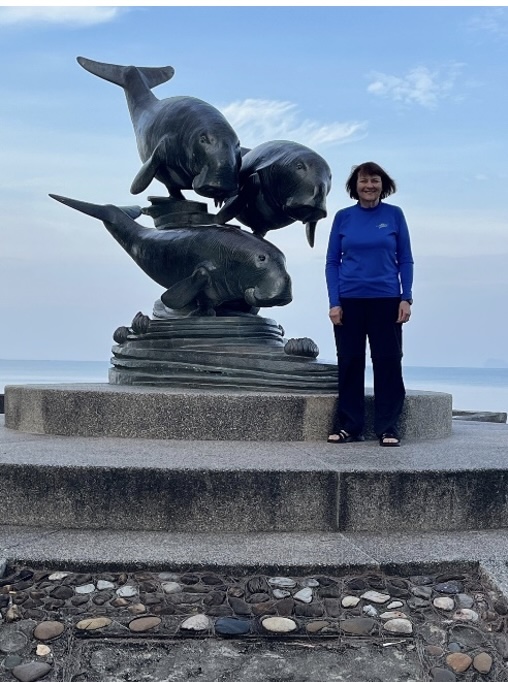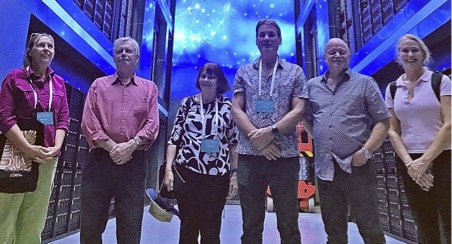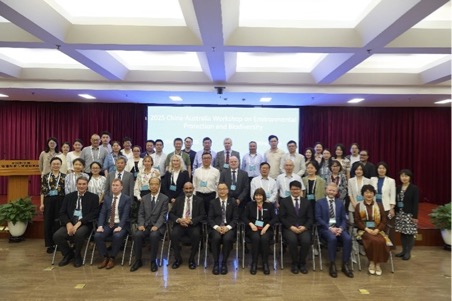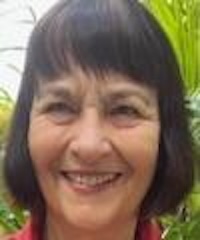|
REGIONAL AND REMOTE QUEENSLAND 
Professor Helene Marsh Dugongs, threatened species, marine biology, research syntheses, and, international diplomacy September, 2025
Our QAAS Fellow, Helene Marsh has been keeping very busy of late. She has ‘refocussed’ rather than ‘retired’. As well as being Professor Emeritus in Environmental Science, Helene has also been recently working as cross-cutting initiative leader for threatened species for the National Environmental Science Program (NESP). Based in the Resilient Landscape Hub, Helene has had the task of reaching out across the four NESP science hubs to synthesise research on threatened species across the Hubs. Helene is a marine conservation biologist with ~50 years’ research experience in threatened species conservation, management and policy, especially concerning tropical coastal and riverine marine mammals such as the dugong. She has provided advice to the United Nations Environment Program and the governments of 14 countries and chaired the Threatened Species Scientific Committee that advises the Australian Minister for Environment from 2011 to 2023. 
Helene on a research visit to Thailand in January 2025 to investigate the cause of seagrass dieback and dugong deaths along the Andaman coast. The dugong is the symbol of the Province of Trang where this photo was taken.
Helene has been a key member of the technical advisory groups that have negotiated and designed protected areas for dugong, a listed migratory species under the Environment Protection and Biodiversity Conservation (EPBC) Act 1999, including: a dugong sanctuary in Torres Strait (a legislative boundary outlined in the Torres Strait Fisheries Management Notice No. 65.), dugong protection areas (declared in legislation under the Fisheries Act 1994 and the Queensland Nature Conservation Act 1992) and the green zones that project dugongs in the Great Barrier Reef Marine Park (Great Barrier Reef Marine Park Zoning 2003) and the Great Barrier Reef Coast Marine Park.
Helene has been involved in dugong well-being and conservation (and the author of countless international publications in this area) since the 1970s. Helene regards this as a long-lasting legacy, along with the more than 60 PhDs she has supervised to completion and who are making a difference all over the world. Helene is still supervising post-graduate students in this area and also taking on the task of coordinating and reporting on the global state of dugongs. This recent work includes editor, coordinator of the new 350-page manuscript (with 72 authors) soon being launched at the World Conservation Congress in Abu Dhabi as part of the Convention on Migratory Species (CMS) under the UN Environment Program. Helene emphasises that Australia is the ‘Dugong Capital of the World’, largely because of our extensive seagrass meadows, our overall low human population in northern Australia, especially in remote areas. Helene notes that the Dugong MoU, an agreement under the CMS, specifically focuses on dugongs and their seagrass habitats. It aims to promote coordinated international actions to ensure the long-term survival of dugongs. As the natural heritage expert on the Australian delegation of the World Heritage Committee, Helene led the drafting group that framed the resolution that led to the committee’s decision to inscribe the ‘Migratory bird sanctuaries along the coast of the Yellow Sea–Bohai Gulf of China (Phase I)’ into the World Heritage List, at the 43rd session of the World Heritage Convention in 2019. The drafting group was formed after IUCN recommended that the listing be deferred, a decision that would have had an adverse impact of the migratory shorebirds of the East Asian–Australasian Flyway that are protected under the bilateral China–Australia Migratory Bird Agreement. Helene’s contributions have been recognised with an Order of Australia and Fellowships of the Australian Academies of Science (AAS) and Technological Sciences and Engineering, the Royal Zoological Society of New South Wales and several prestigious international awards. She is the immediate past Vice-President and Secretary Biological Sciences of AAS. Helene recently participated in a joint AAS/Chinese Academy of Sciences (CAS) Biodiversity and Conservation workshop in Beijing in June, 2025. The workshop showcased existing Chinese-Australian research links as well as highlighting opportunities for further collaborations. The workshop program covered four key themes: terrestrial biodiversity and conservation; river basin management and freshwater biodiversity; marine ecosystem and coastal protection; and climate change and biodiversity conservation. AAS President, Professor Chennupati Jagadish noted at the workshop that China’s commitment to biodiversity research and conservation is clear. “The scale of its conservation actions, particularly their long-term monitoring programs, have no parallel in Australia,” Professor Jagadish said. “There is certainly potential for Australian Chinese research collaboration in areas including migratory shorebirds, plastic ingestion in birds, restoration efforts and research on the biosphere and hydrosphere.” Helene’s visit also included interaction with key research facilities, such as the Earth System Numerical Simulation Facility, EarthLab and the Supercomputing Facility at the Chinese Academy of Sciences’ Institute of Atmospheric Physics. 
Part of the recent (June, 2025) Australian Delegation to the Chinese Academy of Sciences joint workshop on biodiversity and conservation held with the Australian Academy of Science in Beijing. Professor Helene Marsh is in the centre of the photograph (Courtesy Australian Academy of Science). 
A photo of all participants of the 2025 China-Australia Workshop on Environmental Protection and Biodiversity, successfully held in Beijing (courtesy UN Environment Program International Ecosystem Management Partnership). Prof Marsh is seated at the near centre of the front row.
For more information:
Marsh, H., Loates, P.J. and Schramm, L. (2025). A global assessment of dugong status and conservation needs. CMS Office - Abu Dhabi, United Arab Emirates. CMS Technical Series Publication No. 51. https://doi.org/10.25903/0ncx-v838; ISBN: 978-3-937429-40-3 Marsh, H., Albouy, C., Castelblanco-Martinez, D.N., Collier, C., Edwards, H., James, Ca., and Keith-Diagne, L. (2022) How Might Climate Change Affect the Ethology and Behavioral Ecology of Dugongs and Manatees? Ethology and Behavioral Ecology of Sirenia, Marsh, H. (ed) Springer, 351-406. Marsh, H., De`ath, G., Gribble, N., and Lane, B (2005) ‘Historical Marine Population Estimates: Triggers or Targets for Conservation? The Dugong Case Study’ Ecological Applications, https://doi.org/10.1890/04-0673 Marsh, H., Heinsohn, G.E., and Marsh, L.M. (1984) ‘Breeding Cycle, Life History and Population Dynamics of the Dugong, Dugon dugon (Sirenia: Dugongidae)’ Australian Journal of Zoology 32(6) 767 - 788
|





